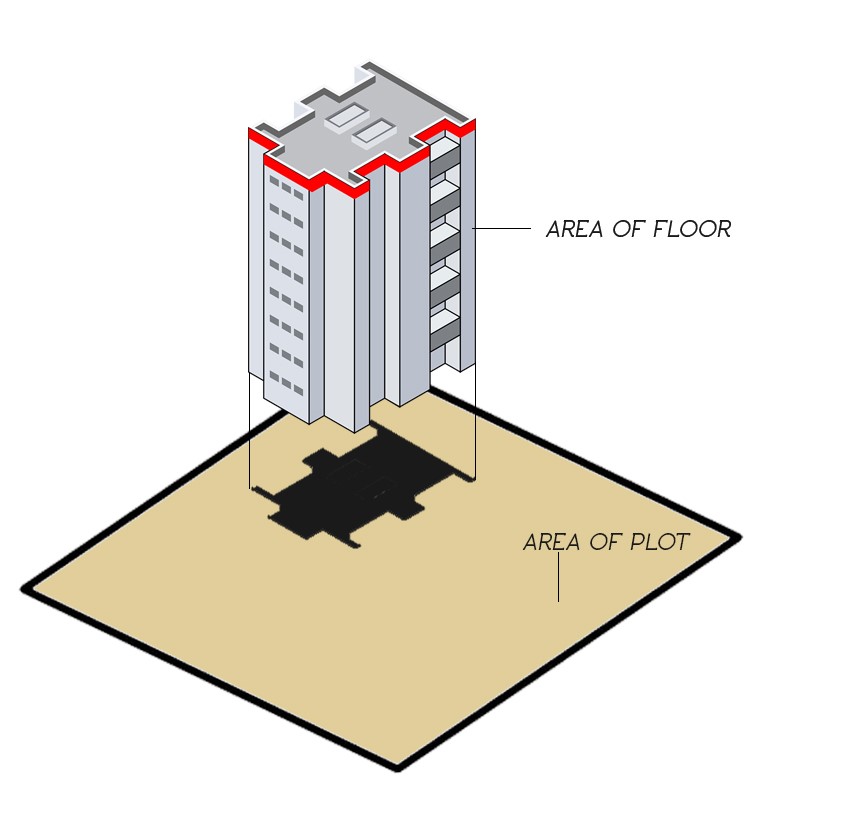Understanding Floor Area Ratio- FAR

- Author: Vikas Tawar
Highlights
FAR could mean total floor area (including the space covered by all the floors in a building) divided by the total area of land on which the plot is being built
When you multiply this number with the total area of land available to you, you get the maximum floor area you can have built on the plot.
A growth in residential units will increase the demand for real estate only initially
What is FAR
The web definition of FAR says that it is the ratio of total building floor area to the area of the plot. However, a layman might find it difficult to understand this. If we simplify the definition, FAR could mean total floor area (including the space covered by all the floors in a building) divided by the total area of land on which the plot is being built. Since the area is expressed in numerical terms, FAR will also come out to be a number. When you multiply this number with the total area of land available to you, you get the maximum floor area you can have built on the plot.
Calculating FAR
If you have to say, 500 sq. feet of land and the government established FAR is 2, the total floor area you can build is 1,000 sq. feet. The ground floor will obviously be 500 sq. feet because that is the size of land available. (Practically, the ground floor will be less than 500 sq. feet because you would leave some parking space and garden area but let us not consider that in this example to keep it simple). Now, you are left with 500 sq. feet and it is possible to make just one more floor. So, if you have 500 sq. feet of land and FAR is 2, the biggest building you can make will be a single storey rectangle.
Impact of a higher FAR
Now, imagine, the FAR is increased to 4. Doing the similar calculations again, now the maximum amount of floor space you will be able to cover will be (500*4), 2000 sq. feet. If you could build two floors in 1000 sq. feet, you will be able to build 4 floors in 2000 sq. feet. This clearly implies that an increase in FAR gives you more area to be covered by the building, resulting in a taller building! Having a bigger building on the same plot of land would sound profitable to an individual and no doubt it is profitable to the owner. However, there are many factors due to which a high FAR may turn out to be disadvantageous. It will result in bigger buildings, more residents which will lead to an over-crowded place, shortage of resources like water because now more people will have to share the same amount of resources, increased pollution, and many more problems.
Increased in FAR in Haryana
Now, what I have to share will become easier to understand. Recently, Haryana Government has approved an increase in FAR. Earlier the FAR range was 1-1.65 and now it is 1.8-2. For plots having areas of 3, 4, 6 and 10 marlas (1 marla=272.25 square feet), the new FAR is 2 and plot areas of 14 Marlas, 1 Kanal (1 kanal=5445 square feet) and 2 Kanal have a FAR value of 1.8.
Why this has been done
The basic question is the reason for such revised limits of FAR. The simplest answer is that it has been done for development. Real Estate Industry is not in its full swing and in Haryana, this industry is down since three years now. As a result, the government is not able to earn as much revenue from this industry as it can. Hence, to improve the revenue generation capacity of real estate industry in Haryana, Government has increased the FAR. This will lead fulfillment of existing housing demands, the creation of new housing demands resulting in increased supply of real estate, which will ultimately lead to price cut fostering even more demand. This is what government thinks and is not at all wrong. However, many other forces come into play, which creates a reciprocal picture of this rosy view.
What will be the impact
- A growth in residential units will increase the demand for real estate only initially. However, property prices will begin to rise once the developments will be done in locations which will again lead to a fall in demand and the very purpose of development behind increasing the FAR will be left unfulfilled.
- Residential real estate is already more developed than the commercial real estate in India. FAR for commercial real estate should have been increased for an establishment of more offices and commercial units. This would have led to a greater development of real estate industry because commercial units would have added to the government revenue by way of their turnovers, taxes, etc.
- More construction in the same area will lead to misuse of the location because of increased number of residents. A peaceful place to stay will turn into a noisy, polluted and dirty locality, disturbing the residents’ peace of mind.
- More developed cities of Haryana like Gurgaon may benefit from a hike in residential units because it has well-maintained amenities to cater to a large number of people without disturbing any one’s life. This will lead to further development of the city. However, less developed cities like Panipat where the locations are already ill maintained will not respond positively to a growth of residents and residential buildings.
- The land is a natural resource that has a certain carrying capacity which when exploited can render the land useless. A high FAR will lead to a construction of bigger residential apartments that may outweigh the land’s carrying capacity. It is because they size of the building will grow vertically, whereas the surface area will remain the same. This can cause damage to the land and to the structure above it which can shake the very establishment of the building, making it an unsafe place to stay.
Thus, although the government has increased the FAR with good intentions, the end result may not come out to be as desired. It would be worth noticing if the positive impact of a higher FAR would be able to overlap the negatives it will bring along!
More Articles
- Online Listing Tips for Real Estate Agents
- How to start a Real Estate business in India - a complete guide !
- Renting Vs Buying property - How will you decide?
- What you should do in Property Management services
- Home Loan Insurance
- How to choose your builder?
- How to ensure fire safety in your home!
- Tips To Keep In Mind While Taking A Home On Rent
- Importance of Home Security
- How to plan your property budget?
- Leased vs. Purchased vs. Co-Working Office Spaces
- Easy Tips to Build an Eco Friendly Home
- Sample Flat - A Trick by a Builder?
- How to have a Beautiful Guest Room? Impress your Guests with these Guest Room Ideas..
- Understanding MCLR and its Effects on Home Loans
- 5 simple ways to close a real estate deal
- Is it worth to buy property near an airport ?
- Home loan tax benefit
- How to be successful in business as an introvert
- Cost effective home decor ideas
- What to Be-Paying Guest or a Tenant??
- Complete guide to start your small business
- Sports township- New trend in India
- Online Listing Tips for Real Estate Agents
- Understanding Floor Area Ratio- FAR
- Town and Country Planning | Meaning and Importance
- Checklist of Important Property Documents- All You Need to Know
- Role of CREDAI in real estate
Copyright © 2025 RERA Filing. All rights reserved.

 Rera
Act
Rera
Act
 Maharashtra
Maharashtra
 Karnataka
Karnataka
 Telangana
Telangana
 Andhra Pradesh
Andhra Pradesh
 Delhi
Delhi
 Uttar Pradesh
Uttar Pradesh
 Haryana
Haryana
 Gujarat
Gujarat
 Bihar
Bihar